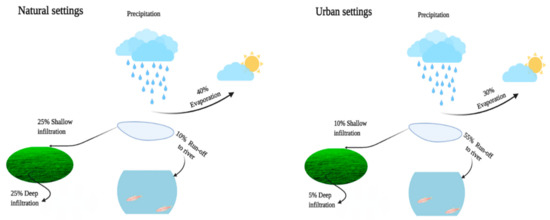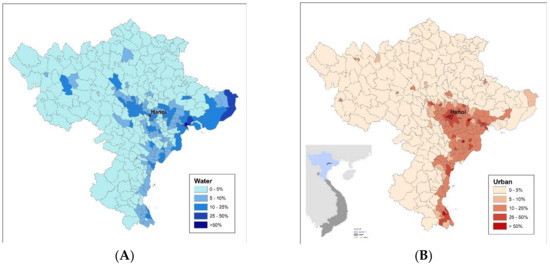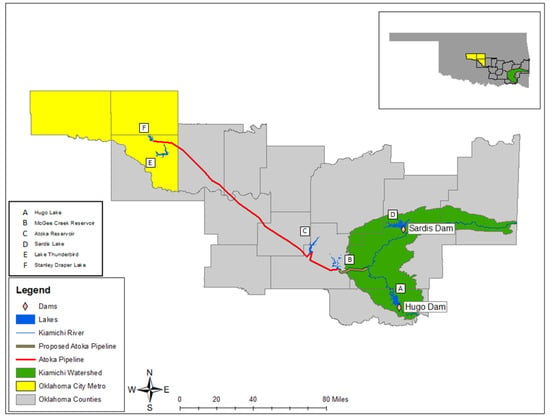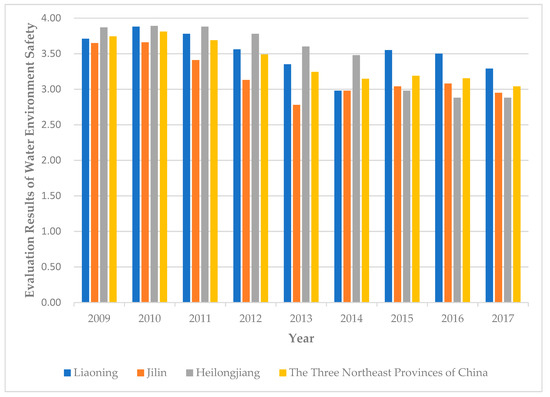Urban Water Consumption and Sustainability
(Closed)
Share This Topical Collection
Editor
 Dr. Vincent Linderhof
Dr. Vincent Linderhof
 Dr. Vincent Linderhof
Dr. Vincent Linderhof
E-Mail
Website
Collection Editor
Wageningen Economic Research, P.O. Box 29703, 2502 LS The Hague, The Netherlands
Interests: water consumption; environmental economiccs; economic instruments; economic aspects of water quality; cost-effectiveness analysis; urban food security
Topical Collection Information
Dear Colleagues,
The world population is growing and at the same time there is a development of urbanization going on. In all continents, more and more people live in cities and depend on the availability of fresh water in the cities. These developments increase the pressure on withdrawal of fresh water resources for urban water consumption. Fresh water resources are depleted due to changing climatic conditions. Moreover, there is a growing competition between different economic activities (households, industries etc.) for the use of water resources. Furthermore, due to the increasing water consumption in urban areas the wastewater discharge is also increasing which cause increasing environmental pollution and associated health issues.
The studies of the Topical Collection are expected to address one of the following issues:
- The development of water consumption in urban areas and associated developments such as waste water and water-related environmental pollution.
- Drivers of urban water consumption and associated developments such a waste water discharge and environmental pollution.
- Rural-urban interactions with respect to availability of water for consumption in urban areas.
- Economic and environmental assessments of technological solutions to reduce the environmental impact of water consumption in urban areas.
- Assessment of supply and demand for water in urban areas such as competing claims, water markets, water pricing, payment for environmental services etc.).
- New challenges such as the emerging issues of medicine residues in waste water, water reuse opportunities etc. related to urban water consumption.
Dr. Vincent Linderhof
Collection Editor
Manuscript Submission Information
Manuscripts should be submitted online at www.mdpi.com by registering and logging in to this website. Once you are registered, click here to go to the submission form. Manuscripts can be submitted until the deadline. All submissions that pass pre-check are peer-reviewed. Accepted papers will be published continuously in the journal (as soon as accepted) and will be listed together on the collection website. Research articles, review articles as well as short communications are invited. For planned papers, a title and short abstract (about 100 words) can be sent to the Editorial Office for announcement on this website.
Submitted manuscripts should not have been published previously, nor be under consideration for publication elsewhere (except conference proceedings papers). All manuscripts are thoroughly refereed through a single-blind peer-review process. A guide for authors and other relevant information for submission of manuscripts is available on the Instructions for Authors page. Sustainability is an international peer-reviewed open access semimonthly journal published by MDPI.
Please visit the Instructions for Authors page before submitting a manuscript.
The Article Processing Charge (APC) for publication in this open access journal is 2400 CHF (Swiss Francs).
Submitted papers should be well formatted and use good English. Authors may use MDPI's
English editing service prior to publication or during author revisions.
Keywords
- urban water consumption
- environmental pollution
- water markets
- water pricing
- urbanization
Published Papers (6 papers)
Open AccessEditor’s ChoiceArticle
Sustainability Analysis of a Municipal Wastewater Treatment Plant through Emergy Evaluation
by
Ramona Ciobanu, Carmen Teodosiu, Cecilia M. V. B. Almeida, Feni Agostinho and Biagio Fernando Giannetti
Cited by 2 | Viewed by 1566
Abstract
Water and wastewater treatment plants are essential for the supply of drinking water for consumption and the treatment of effluents produced by human/industrial activities. However, few studies deal with the investments and sustainability of these services, which consider both the contribution of nature
[...] Read more.
Water and wastewater treatment plants are essential for the supply of drinking water for consumption and the treatment of effluents produced by human/industrial activities. However, few studies deal with the investments and sustainability of these services, which consider both the contribution of nature and society. This study uses the emergy approach to evaluate a wastewater treatment plant located in the northeastern part of Romania, in Iași city. An assessment of the environmental costs of natural fluxes required for the treatment processes was performed, considering that the treated effluent is, still, loaded with contaminants that have to be absorbed by the receiving water natural system. The work done by nature to assimilate this load, generally considered free, is esteemed as a further cost in the total emergy budget of the wastewater treatment processes. The sustainability perspective was approached by calculating and analyzing the emergy yield ratio (EYR), environmental load rate (ELR), and emergy sustainability development index (ESI). The use of local renewable natural resources in Iași municipal wastewater treatment plants is negligible (1.71% of the total plant emergy budget), as compared to that of the purchased resources (98.29% of the total plant emergy budget) mainly processed with the support of fossil fuels’ generated energy. The unit emegy value was, also, calculated and compared to other studies relevant for wastewater treatment plants. The analysis suggests that the large amount of emergy that wastewater contains is proportional to the number of resources employed for wastewater treatment and the extensive effects on surrounding ecosystems, where wastewater is discharged.
Full article
►▼
Show Figures
Open AccessReview
The Common Approaches of Nitrogen Removal in Bioretention System
by
Wafaa Ali, Husna Takaijudin, Khamaruzaman Wan Yusof, Manal Osman and Abdurrasheed Sa’id Abdurrasheed
Cited by 8 | Viewed by 2968
Abstract
Bioretention is considered one of the best management practices (BMPS) for managing stormwater quality and quantity. The bioretention system has proven good performance in removing total suspended solids, oil, and heavy metals. The nitrogen (N) removal efficiency of the bioretention system is insufficient,
[...] Read more.
Bioretention is considered one of the best management practices (BMPS) for managing stormwater quality and quantity. The bioretention system has proven good performance in removing total suspended solids, oil, and heavy metals. The nitrogen (N) removal efficiency of the bioretention system is insufficient, however, due to the complex forms of nitrogen. Therefore, this paper aims to review recent enhancement approaches to nitrogen (N) removal and to discuss the factors influencing bioretention efficiency. To improve bioretention efficiency, several factors should be considered when designing bioretention systems, including nitrogen concentration, climate factors, and hydrological factors. Further, soil and plant selection should be appropriate for environmental conditions. Three design improvement approaches have been reviewed. The first is the inclusion of a saturated zone (SZ), which has been used widely. The SZ is shown to have the best performance in nitrogen removal. The second approach (which is less popular) is the usage of additives in the form of a mixture with soil media or as a separated layer. This concept is intended to be applied in tropical regions with wet soil conditions and a short dry period. The third approach combines the previous two approaches (enhanced filter media and applying a SZ). This approach is more efficient and has recently attracted more attention. This study suggests that further studies on the third approach should be carried out. Applying amendment material through filter media and integrating it with SZ provides appropriate conditions to complete the nitrogen cycle. This approach is considered a promising method to enhance nitrogen removal. In general, the bioretention system offers a promising tool for improving stormwater quality.
Full article
►▼
Show Figures
Open AccessArticle
The Impact of Water-Related Pollution on Food Systems in Transition: The Case of Northern Vietnam
by
Vincent Linderhof, Marieke Meeske, Vasco Diogo and Anne Sonneveld
Cited by 4 | Viewed by 2592
Abstract
In Vietnam, agricultural practices such as fertilizer and pesticide use affect the landscape as well as the availability and safety of food. For instance, pesticides and fertilizer end up in surface water used for drinking water, crop irrigation, and in fish tanks. However,
[...] Read more.
In Vietnam, agricultural practices such as fertilizer and pesticide use affect the landscape as well as the availability and safety of food. For instance, pesticides and fertilizer end up in surface water used for drinking water, crop irrigation, and in fish tanks. However, the link to actual food consumption and health is complex and information is lacking. This study considers potential water-related exposure to toxic hazards in northern Vietnam food systems, through the consumption of food commodities and of water. Water pollution is operationalized by considering the following two channels: (i) pesticide and nutrient leaching to surface water (share of surface water) and (ii) industrial runoff from facilities located in urban areas (share of urban areas). We explore how potential exposure to toxic hazard is related to food consumption choices. Using a sample of the Vietnam Household Living Standard Survey (VHLSS) for 2014, we estimate how shares of food consumption categories in total food consumption are affected by household and landscape characteristics, the latter also reflecting potential environmental pressures. In districts with higher shares of surface water, the share of fish consumption is higher and the share of meat consumption is lower. From an environmental and health perspective, households in water-rich areas thus may have a higher probability of being exposed to toxic chemicals due to higher fish consumption. In districts with higher shares of urban areas, the shares of meat and cereals in total food consumption value were lower, and the shares of fish and fruit and vegetables were higher. The results indicate that food consumption is affected by landscape characteristics that may also influence the level of exposure to water-related environmental pressures, and that this combined effect may potentially exacerbate food safety and health risks. The actual impact is more complex and should be analyzed with more sophisticated data and methods.
Full article
►▼
Show Figures
Open AccessArticle
A Panel Data Estimation of Domestic Water Demand with IRT Tariff Structure: The Case of the City of Valencia (Spain)
by
Mónica Maldonado-Devis and Vicent Almenar-Llongo
Cited by 3 | Viewed by 2072
Abstract
In urban water provisioning, prices can improve efficiency, contributing to the achievement of the environmental objective. However, household responses to price changes differ widely based on the household characteristics. Analyses performed at the aggregate level ignore the implications of water demand incentives at
[...] Read more.
In urban water provisioning, prices can improve efficiency, contributing to the achievement of the environmental objective. However, household responses to price changes differ widely based on the household characteristics. Analyses performed at the aggregate level ignore the implications of water demand incentives at the individual household level. A large data sample at the household level enables estimation of econometric models of water demand, capturing the heterogeneity in domestic consumption. This study estimated the domestic water demand in the city of Valencia and its elasticity, along with the demands of its different districts and neighbourhoods (intra-urban scale analysis). Water price structure in Valencia is completely different from that of other Spanish cities: it is a price structure of increasing volume (increasing rate tariffs, IRT). For this estimation, from a microdata panel at the household level, the demand function with average prices for the period 2008–2011 was estimated using panel data techniques including a fixed effect for each neighbourhood. The domestic water demand elasticity at the average price in Valencia was estimated at −0.88 (which is higher than that estimated for other Spanish cities). This value indicates an inelastic demand at the average price of the previous period, which can cause consumers to overestimate the price and react more strongly to changes.
Full article
►▼
Show Figures
Open AccessEditor’s ChoiceArticle
Revisiting a Water Conflict in Southeastern Oklahoma 6 Years Later: A New Valuation of the Willingness to Pay for Ecosystem Services
by
Claire Burch, Michelle Busch, Edward Higgins, Steven Bittner, Nuwanthika Perera, Kevin Neal, Lawrence Burkett, Antonio J. Castro and Christopher Anderson
Cited by 12 | Viewed by 4052
Abstract
In recent years, researchers have begun to adopt a perspective evaluating “winners and losers” regarding the consumption and value of ecosystem services. “Winners” tend to benefit from the ecosystem service and “losers” absorb most associated costs. Our study focuses on water use in
[...] Read more.
In recent years, researchers have begun to adopt a perspective evaluating “winners and losers” regarding the consumption and value of ecosystem services. “Winners” tend to benefit from the ecosystem service and “losers” absorb most associated costs. Our study focuses on water use in Oklahoma (USA) and a plan to divert water from the Kiamichi River in southeastern Oklahoma for consumption at residences in the Oklahoma City metropolitan area. Our study is, in part, a follow-up from an initial 2013 survey of Oklahoma City residents and residents of the Kiamichi. For this paper, a survey was distributed within the state of Oklahoma to evaluate changes to ecosystem service willingness to pay and valuation. This survey also included an experimental element assessing if exposure to additional information about ecosystem services influenced respondents on ecosystem service valuation, or willingness to pay. Our results generally aligned with those found in the 2013 survey. Oklahoma City residents are not aware of where their water is coming from and are not willing to pay to protect ecosystem services, despite an overall increase in activism. Our results indicate that a smaller number of significant factors determining willingness to pay for ecosystem service maintenance were identified than the study in 2013. Exposure to additional information had no effect on peoples’ preferences. We found that public opinion surrounding environmental support is context-specific, political conservatism may not always impede valuation of environmental protections. We conclude that cultural, moral, and political values interact in their influence on expressions of valuation and willingness to pay for ecosystem services.
Full article
►▼
Show Figures
Open AccessArticle
Evaluation Methods of Water Environment Safety and Their Application to the Three Northeast Provinces of China
by
Yuangang Li, Maohua Sun, Guanghui Yuan and Yujing Liu
Cited by 7 | Viewed by 2561
Abstract
Focusing on the topic of water environment safety of China, this paper has selected the three northeast provinces of China as the research object due to their representativeness in economic development and resource security. By using the Entropy Weight Method, the Grey Correlation
[...] Read more.
Focusing on the topic of water environment safety of China, this paper has selected the three northeast provinces of China as the research object due to their representativeness in economic development and resource security. By using the Entropy Weight Method, the Grey Correlation Analysis Method, and the Principal Component Analysis Method, this paper has first constructed a water environment safety evaluation system with 17 indicators from the economic, environmental, and ecological aspects. Furthermore, this paper has screened the initially selected indicators by the Principal Component Analysis Method and finally determined 11 indicators as the evaluation indicators. After indicator screening, this paper has adopted the improved Fuzzy Comprehensive Evaluation Method to evaluate the water environment safety of the three northeast provinces of China and obtained the change in water environment safety of different provinces from 2009 to 2017. The results show that the overall water environment safety of the region had improved first but worsened afterward, and that in terms of water safety level, Jilin Province ranked first, followed by Heilongjiang Province and Liaoning Province. The three factors that have the greatest impact on the water environment safety of the three provinces are: Liaoning—Chemical Oxygen Demand (score: 17.10), Per Capita Disposable Income (score: 13.50), and Secondary Industry Output (score: 11.50); Heilongjiang—Chemical Oxygen Demand (score: 18.64), Per Capita Water Resources (score: 12.75), and Concentration of Inhalable Particles (score: 10.89); Jilin—Per Capita Water Resources (score: 15.75), Chemical Oxygen Demand (score: 14.87), and Service Industry Output (score: 11.55). Based on analysis of the evaluation results, this paper has proposed corresponding policy recommendations to improve the water environment safety and promote sustainable development in the northeast provinces of China.
Full article
►▼
Show Figures











